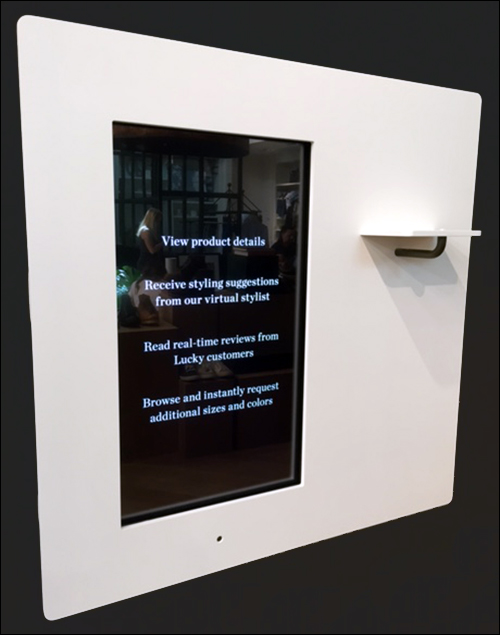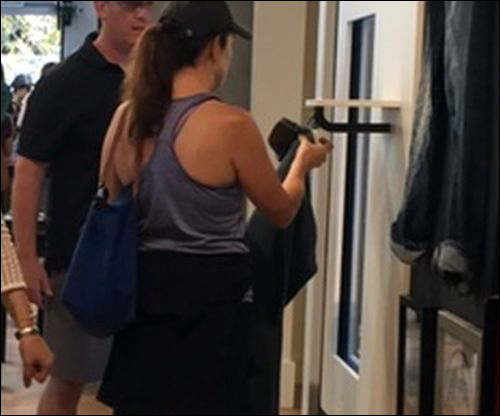Nov 04, 2015This summer, jeans and general clothing retailer Lucky Brand opened two new stores in the United States, each equipped with an RFID system that allows a customer to view how a garment looks on a model, learn more about that item and determine which sizes are available in the store or via the Internet. Catalyst, a U.K. electronic article surveillance (EAS) and retail technology firm, provided the solution, which consists of Keonn Technologies' RFID-enabled touchscreens and Keonn's software on a cloud-based server.
Lucky Brand already had a relationship with Catalyst's parent company, global supply chain manager Li & Fung Co.. More than a year ago, says Roxanne Christenson, Catalyst's technology solutions manager for North America the retailer, Lucky Brand began working with Catalyst to create an RFID solution for two new stores it was opening: one in El Segundo, Calif., and the other in Summerlin, Nev.

The retailer sought a solution that would help bridge the physical store and online products, since the stores don't have all of Lucky Brand's product line in stock; considerably more is available via online ordering. However, it also wanted to ensure that it did not lose the personal touch afforded by a sales associate speaking with a customer and helping that person individually when needed. "Lucky Brand is really focused on the personal, human element to the [shopping] process," Christenson says.
The two new stores are about twice the size of most Lucky Brand locations, each at about 5,000 square feet, according to Jason Richard, Lucky Brand's CIO. Because of that extra size, he explains, there was room for a large screen on the sales floor. The technology offers a new way to reach out to customers, Richard says, adding, "It will keep people interested and in the store longer… We can cross-sell by offering other items. The whole idea is to make customers more inclined to ask for another product."
Goods arrive at the stores from a variety of vendors. When each item is received, staff members use a Zebra Technologies ZT410 printer-encoder to print an RFID tag, which is then attached to the product's existing hangtag. (The retailer is using RFID tags from a variety of suppliers, including Smartrac.) A worker uses a Catalyst handheld device with a built-in RFID AdvanScan reader from Keonn to encode the tag with a unique ID number and link that ID to that particular product's stock-keeping unit (SKU). The items are then displayed on sales floor fixtures.
Upon selecting a product, a customer can hold it within a few feet of the 46-inch touchscreen installed on a wall located in the sales area. The touchscreen's built-in ultrahigh-frequency (UHF) RFID reader captures the tag's unique ID, after which the cloud-based software pulls up Lucky Brand's content for that product. The content can include multiple still shots of a model wearing that garment, or a video showing how the item moves on the body when worn. Content also includes other merchandise that might accompany or is similar to that product, as well as other colors or sizes of the item itself, and whether they are available in the store.
If the customer would like to see or try on any items that are available in-store, or order something online, he can press the prompt to request assistance and input his first name so that the associate can identify that person. Once the request is made, the worker can view that request via a Keonn app running on her iPad, selecting that request if she intends to respond. Keonn's cloud-based software receives that selection and displays that employee's name on the touchscreen, so that the customer knows who will be responding.
When the associate arrives at the touchscreen, she can bring the requested garments if they are in the store, or peruse the items that interest the customer on the screen. Alternatively, she can use her iPad to place an order for a product that isn't available at that location, so that it can be shipped to the customer's home.
By enabling shoppers to request help from sales personnel in the store, Christenson says, the system ensures that there is a human element to the shopping experience, even if a product is ordered online.
In the fitting room, smaller versions of the Keonn touchscreens with readers are installed. To prevent stray reads from occurring, Catalyst instructed Lucky Brand to paint the fitting rooms with a primer paint that blocks RF transmissions. A shopper who enters the fitting room may bring several items with her. The touchscreen's built-in reader captures every item's tag ID and displays content about those garments and related products. (The touchscreens in the fitting room and on the sales floor can display content for up to 12 tagged items simultaneously.)
If the shopper in the fitting room tries on an item and finds that she needs a different size, or wants to try on a similar item or find something to accompany it, she can press the screen's prompt. A store associate will receive the request on his iPad and respond, and the customer will then see that response, along with the associate's name. The employee can then help the shopper find the right items, and make an online purchase if the garment or accessory she wants is not available in the store.
In the long term, Lucky Brand wants to use the RFID tags for more than just smart mirrors, but also for inventory management and business analytics. In the latter case, Richard says, the stores could better identify which items are selling well and which are being tried on but not purchased, which could indicate a potential problem. The system can offer this information based on data indicating which items were taken into the fitting room, compared against sales data that would let the company know which garments tried on were actually sold. "If people are always trying something on, but then are ordering a different color," Richard explains, that information could help the retailer better identify which colors its stores should stock.

The stores can also use the handheld readers for inventory tracking, though they have not done so yet. The company plans to benchmark the system for inventory management against a manual inventory count in January 2016, Richard says.
Regarding the two stores' RFID-based technology, Richard adds, "customers find it interesting. They do play with it." It is still too soon to report any effect that the solution may have had on total sales, he notes, stating, "It's early days, but we do know that [the system] attracts people to it. We're evaluating future plans for the technology in other stores."


